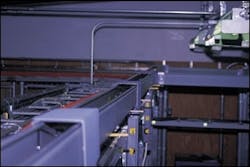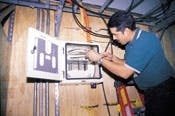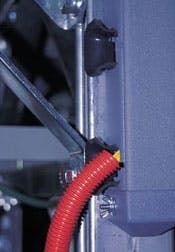Where airport runways and cabling raceways meet
Fiber-optic ring and intricate raceways play key role in high-speed networking system at the new San Francisco airport international terminal.
CAROL EVERETT OLIVER, Everett Communications
When flying these days, sometimes you have to look at your tickets to figure out which airport you're at, since airports seem to look the same-under construction. How familiar is the sign, "Pardon our appearance during renovations." Indeed, it seems that most, if not all, of the major airports in the United States are going through massive overhauls and updates to make them more efficient to handle the increasing number of travelers.
One of the largest airport construction sites, which is about to embark on its final phase and is scheduled for completion this fall, is located at the so-called "Gateway to the Pacific." San Francisco International Airport is dealing with a unique conglomeration of challenges. Take, for instance, its set of parallel runways that are just 750 ft apart. For first time travelers to San Francisco, landing alongside another incoming aircraft can be an eye-opening experience. If weather conditions over the Bay Area aren't perfect, airplanes are forced to land on the runways on an alternating basis. This situation has wreaked havoc with flight patterns, schedules, air-traffic control, and communications. Problems on the runways lead to backups inside the terminal.
The airport's communications system was quickly becoming outdated. Add to that other unique problems like the dense area on which the airport is built, not to mention the challenging terrain. Any additions to the existing airport terminal meant building over current roadways, meeting tough earthquake-proof building codes, and Federal Aviation Administration standards.
The millions of bicoastal and international travelers will be relieved that the newly expanded San Francisco airport, or SFO, will include a new international terminal as well as major upgrades to its current terminals. The new state-of-the- art complex will include an efficient transportation system on the ground, on the runways, and in the raceways. In addition, a new information highway of fiber-optic-based, high-speed cabling infrastructure will connect all networking and communications between the terminals, making the SFO the largest U.S. international terminal and one of the world's premier airports.
"In 1995, we began to see the demand for international travel rise by 10% per year," says San Francisco airport's community affairs director, Ron Wilson. "We needed to develop a master plan to handle our growing travel population. We needed to encompass not only additional flights and travelers, but also local area commuters to the airport. All this had to be tied into an updated and efficient communications system which could handle the growth in the near future as well as long term."
The San Francisco Airport Commission has estimated to issue revenue bonds of up to $2.4 billion to fund a new international terminal consisting of an additional 2.5 million sq ft, which doubles the size of the existing terminals. The new terminal will house 24 new international gates, twice as much counter space, and two nine-story parking garages. In addition, an above-ground rail system called "Air Train" will link all sections together, including the parking lots, existing terminals, Bay Area Rapid Transit, and connection to the car rental building. At the same time, the planners wanted to make sure their communications infrastructure would be supported by the proposed fiber-optic-based networking system.The new international terminal at San Francisco International Airport is scheduled to open this fall and will add 2.5 million sq ft to the existing terminal.(Photo by Carol Oliver)
The SFO, which is owned by the city and county of San Francisco, put the project out to bid. Skidmore Owens Merrill became the prime architect of this area's largest public-works project. Each individual facet of subcontracting for construction was also bid out. Sasco Data Systems (Santa Clara, CA) won the bid for the communications and wiring of the new terminal as well as connecting the system to the existing terminals. Sasco selected and specified an Alcatel (San Ramon, CA) fiber-optic infrastructure system utilizing Lucent fiber-optic cable and Ditel (Bohemia, NY) as the main supplier of raceways for cable protection and the preferred supplier of all fiber termination equipment.
"The decision by the Airport Com mission was to migrate from a copper-based system to a more reliable fiber-optic ring," explains Dale Mullen, acting director of IT&T (information technology and telecommunications) for the SFO. "Up until this point, we have been a traditional analog copper plant. But we had a history of cable cuts due to ongoing construction crews. Many travelers might even remember the infamous date of Sept. 30, 1999, when a cable cut led to the inability of some airlines to launch flights, which lead to compounding problems on the ground," explains Mullen. The fiber-optic cable installed in underground conduits will not only change the reliability of their communications system, but also will enable the Airport Commission to assume system integrity from the initial fiber termination point to the horizontal wiring to each airline.
The scope of the installation was very sensitive to limit cable runs and concise termination equipment in order to provide the most efficient class of service to the customers, the airlines themselves. The fiber-optic-cable backbone consists of about 20 miles of 48-strand singlemode fiber, which connects to all of the six airport facilities, two of which are directly part of the new international terminal. The fiber-optic cable and all services of the OC-48 SONET fiber ring are terminated in a minimum point of entry (MPOE). To prevent a single point of failure, an alternate point of entry (APOE) is being constructed.
The outside-plant backbone cable is terminated into the Ditel optical splice-closure cabinet in the MPOE. "There is enough capacity for holding up to 144 fiber terminations in one box," says Hector Juarez, Jr., project engineer for Sasco Data Systems at the SFO site. "For future expansion and applications, we will provide a special Sidekick fiber-termination module that can house up to 72 terminations."
Alcatel provided the crossconnect system and equipment for both data and voice. "We can break down the backbone fiber to DS-1 grade through DS-x panels," explains Bohnie Forrester, the installer for Alcatel at the airport. "The cables are then muxed up to the OC-12 rate through the central switch and through our equipment so that voice and data can pass through T1 lines. This allows high speed capabilities of data and voice applications to the customers, which are the airlines."The Lightrax Raceway System, which runs next to the cable tray and is fastened to the metal seismic bracing system, protects the fiber-optic patch cords between the termination equipment.(Photo by Carol Oliver)
"Although the horizontal fiber-optic cables and some copper cabling were installed in cable trays," adds Juarez, "we wanted to make sure that the patch cords between the equipment were protected separately. If something happened to the patch cords and they failed, that would disrupt the entire system. We were already terminating the fiber when I realized that we needed a separate raceway system for the patch cords between the equipment rack which holds the router, hub, and transceiver, in the MPOE and in the intermediate closets."
"We find that in a lot of fiber-optic-cable installations, raceway is an afterthought or completely overlooked," remarks Bob Auteri, vice president of Ditel. "However, after all the expense of putting in an efficient fiber-optic cabling system, it would be a shame not to protect that investment. It is vital that the fiber is properly managed and protected when traveling from the building entrance point to the indoor termination hardware and patched to other networking equipment. This will assure the network's reliability over use and over time. Sasco Data Systems, together with our rep, Mike Young and Associates, selected to install the Ditel Lightrax Raceway System with our modular splice and patch enclosure."
"We originally spec'ed in the 2-inch tray system that could hold up to 200 patch cords," Juarez notes, "but in the long run, we decided that the 4-inch trays with capacity to hold up to 400 cords would be better for cable management in the MPOE. With four termination boxes with capacity to hold 144 terminations each, a wider raceway was preferred. We reviewed each of the 49 termination closets to assure the proper installation of the cable-management system, which includes the raceways." The Lightrax Raceway System was installed along the same pathways as the cable trays.
To meet the building codes of San Francisco, which sits on the San Andreas fault, the raceways and cable trays had to be fastened to a metal seismic bracing system, so in the event of an earthquake, the cable tray or raceway will not fold down. "The building may crumble, but we will guarantee our cable installation," cites Juarez.
The newly installed fiber-optic system is making landlords out of the Airport Commission's telecommunications department. "We are establishing a minimum point of entry for the local-exchange carriers by constructing a central office, the MPOE," reports SFO IT&T's Mullen. "The public carriers come to us over our OC-48 SONET fiber-optic ring. The airport is then responsible for delivering all services from the MPOE to each tenant, which includes all airlines, concessions, and other tenants on the property. When somebody orders up a data circuit from AT&T, that service will be delivered over the national carrier to the MPOE, and at that point they will select the ILEC [incumbent local-exchange carrier) or CLEC [competitive local-exchange carrier]."
Traditionally, there would be a local loop to go directly to customers. Now, the service goes from the server infrastructure and rides over the airport's own fiber infrastructure out to the customer. "This requires a high degree of coordination between the user and the [exchange] carrier," Mullen points out. "We now have maintenance and response issues to handle. As a result, we are providing 24-hour, 7-day help desk and support operations."The outside-plant backbone cable is terminated into an optical splice-closure cabinet at the minimum point of entry. "There is enough capacity for holding up to 144 fiber terminations in one box," says project engineer Hector Juarez, Jr.(Photo by Carol Oliver)
In addition to the fiber backbone, the airport is installing copper cable along parallel lines with the fiber. "We can never completely divorce ourselves from copper, as we still need it for control and radio circuits," he reasons. "Fiber, which is more reliable, was installed in conduits and hardened protective facilities to protect our investment in our networking future."
The changeover to the entirely fiber-based system will take place in phases, with the opening of the new international terminal being the first phase. Over a short time period, the fiber infrastructure will be extended airport-wide.
What about the resolution of those parallel runways? Redoing an entire airport campus has to be resolved in stages, since construction takes place while all airport operations are up and running. The runway configuration planning will be ongoing even after the new terminal is open this fall. "We're in the throes of another contest for worldwide designers to submit plans for redesigning our runways to handle and any upcoming new generation of aircraft," notes community affairs director Wilson. "In the future, our runways will be separated by 4,300 ft to make them FAA approved, even during inclement weather. This may even mean building jetties over the Bay."The fiber-optic cable is protected from the termination equipment to the raceway entrance through flexible conduit. Once the fiber-optic cable is safely enclosed in the raceway system, it is protected to the next active equipment. The raceways have multiple openings for easy access in conduits that connect to the wire-management racks.(Photo by Carol Oliver)
Today, there are aircraft being developed that will hold 650 passengers and be used mainly for international travel. Major international gateways such as San Francisco are preparing for the future. The new runways, combined with the new fiber raceways, will position San Francisco to successfully handle unfolding ventures such as new networks, new airlines, new aircraft, and even the weariest of new travelers.
Carol Everett Oliver of Everett Communications (Ashland, MA) is a freelance technical writer in the telecommunications industry.


